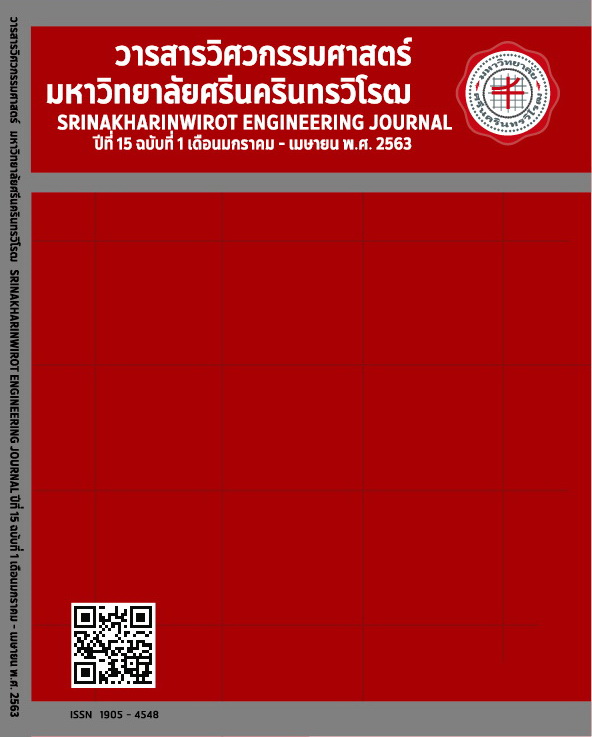Pepper Drying Using by Spouted Bed Combined with Fluidized Bed Technique
Main Article Content
Abstract
This research is aimed at examining the dehumidification of pepper seeds by using spout fluid bed dryer. The objectives of this study were the kinetic of dehumidification of pepper seeds and the consequence of factors (i.e. temperature, velocity of hot air, drying time per power and quality used). From the results, it was found that the spout velocity of 24 m/s, the fluid velocity of 9 m/s, the temperature of 90 oC and the bed height of 10 cm are the fastest condition which can decrease moisture content of pepper seeds. The specific energy consumption (SEC) of the drying process was found at the spout velocity of 18 m/s, the fluid velocity of 9 m/s, the temperature of 90 oC and the bed height of 15 cm are 7.936 kWh/kg water, which was the minimum of the specific energy consumption of the drying process (SEC). The color of pepper seeds while using high temperature will become more red and darker than using low temperature in every condition. In addition, the destruction of pepper seeds is in range of 0.054 to 0.382 % with the spout velocity of 18 m/s, temperature of 90 oC, bed height of 10 cm and blocking of the fluid velocity, which made the destruction of pepper seeds were lowest. The velocity of fluidized was blocked cause less movement of bed which make the destruction of pepper seeds decreased.
Article Details
Copyright belongs to Srinakharinwirot University Engineering Journal
References
E.K. Akpinar, Y. Bicer and C. Yildiz, “Thin layer drying of red pepper,” Journal of Food Engineering, Vol. 59, No.1, pp. 99-104, 2003.
V.S. Sutkar, N.G. Deen and J.A.M. Kuipers, “Spout fluidized beds: Recent advances in experimental and numerical studies,” Chemical Engineering Science, Vol. 86, pp.124-136, 2013.
E.R. Monazam, R.W. Breault and J. Weber, “Analysis of maximum pressure drop for a flat-base spouted fluid bed,” Chemical Engineering Research and Design, Vol. 12, no. 2, pp. 43-51, 2017.
W. Zhong, X. Chen and M. Zhang, “Hydrodynamic characteristics of spout-fluid bed: pressure drop and minimum spouting/spout-fluidizing Velocity.” Chem. Eng. J., Vol. 118, pp. 37-46, 2006.
Y. Zhang, W. Zhong, and B. Jin, “New method for the investigation of particle mixing dynamic in a spout-fluid bed.” Powder Technol., Vol. 208, pp. 702-712, 2011.
L. MarmoL, “Low temperature drying of pomace in spout and spout-fluid beds.” J. Food Eng., Vol. 79, pp. 1179-1190, 2007.
H.J. Ciro-Vela ´squez, R.L. Cunha and F.C. Menegalli, “Drying of Xanthan gum using a two-dimensional spouted fluidized bed (2DSFB) with inert particles : performance and rheological considerations.” Drying Technol., Vol. 28, pp. 389-401, 2010.
M.Zielinska and M. Markowski, “Drying behavior of carrots dried in a spout-fluidized bed dryer,” Drying Technol., Vol.25, pp. 261-270, 2007.
I. Biaobrzewski, M. Zielinska, A.S. Mujumdar and M. Markowski M, “Heat and mass transfer during drying of a bed of shrinking particles -simulation for carrot cubes dried in a spout-fluidized bed drier.” Int. J. Heat Mass Transfer, Vol. 51, pp. 4704-4716, 2008.


